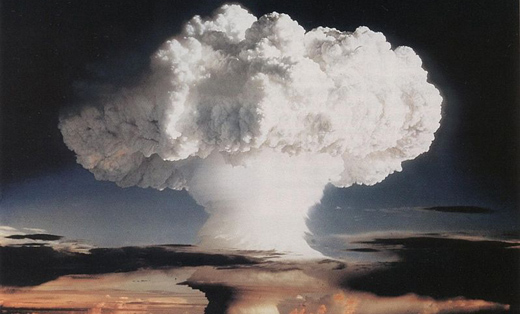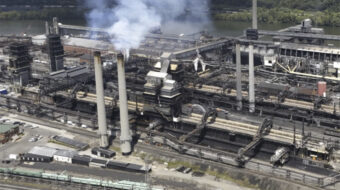
“Plastics,” was the one-word career advice Dustin Hoffman’s character famously received in the 1967 film “The Graduate.” The film heralded a new social era under way in America. But plastics and their technology twin, nuclear weapons, both going into mass production in the post-World War II years, actually marked a new planetary era that has put us all in a test tube, scientists say. Geological remains of the advent of nuclear weapons and mass industrial production of plastics in 1945-1950 mark the start of the era of human impact on our planet, they suggest.
A growing number of geologists who study the history of the Earth have been saying that we have entered a new geological era known as the Anthropocene, in which human action is changing the physical world around us. In a column earlier this year, New York Times science writer Andrew Revkin called this new “geological age of our own making” a real-life “experiment well under way, and we’re all in the test tube.”
Now, Revkin reported, 26 members of an international scientific working group on the topic, in a paper published in January, point “roughly to 1950 as the starting point, indicated by a variety of markers, including the global spread of carbon isotopes from nuclear weapon detonations starting in 1945 and the mass production and disposal of plastics.”
In a summary of the paper, Dr. Jan Zalasiewicz of the University of Leicester, chair of the Anthropocene Working Group of the International Commission on Stratigraphy, wrote: “Humans have long affected the environment, and ideas as to when the Anthropocene might start range from the thousands of years ago with the dawn of agriculture, to the Industrial Revolution – and even to the future (for the greatest human-made changes could still be to come).”
But, he said, the working group members suggest that “the key turning point happened in the mid-twentieth century. This was when humans did not just leave traces of their actions, but began to alter the whole Earth system. There was a ‘Great Acceleration’ of population, of carbon emissions, of species invasions and extinctions, of earth moving, of the production of concrete, plastics and metals.
“It included the start, too, of the nuclear age, when artificial radionuclides were scattered across the Earth, from the poles to the Equator, to be leave a detectable signal in modern strata virtually everywhere.”
“The proposal …. is that the beginning of the Anthropocene could be considered to be drawn at the moment of detonation of the world’s first nuclear test: on July 16th 1945.”
The scientists base this finding on studies of the boundaries that show up in rocks and soil between “humanly modified ground” and natural geological deposits.
Nuclear weapons and plastics are perhaps the most controversial products of modern science. Their harmful impacts on human life range from the devastation of Hiroshima and Nagasaki to toxins in our air, water and soil. Now, we see that they are changing the Earth itself, and we don’t know what the long-term consequences will be.
Zalasiewicz commented, “The evidence is pretty good that humans have changed the Earth pretty substantially and in novel ways. We’re culturally evolving many times faster than biological evolution and that’s driving this whole Earth-system change… where it’s going to go is anybody’s guess…. We have to become wise enough to manage the changes that we’re creating.”
Photo: “Ivy Mike,” an atmospheric nuclear test conducted by the U.S. at Enewetak Atoll on Nov. 1, 1952. It was the world’s first successful hydrogen bomb. Wikimedia










